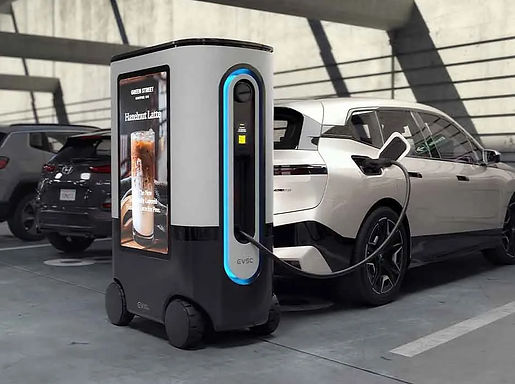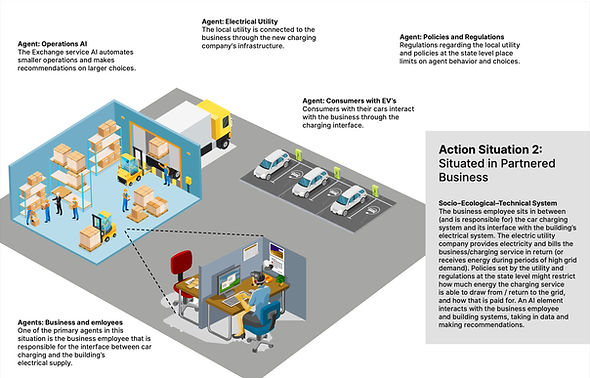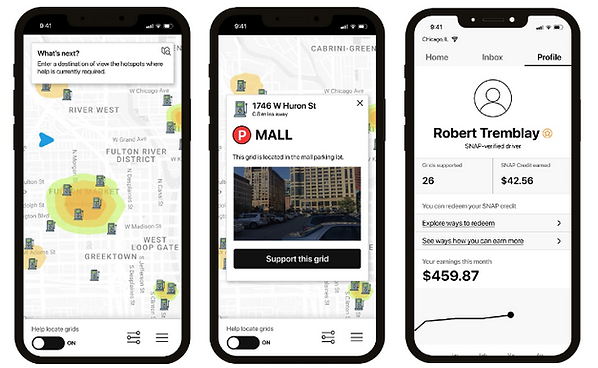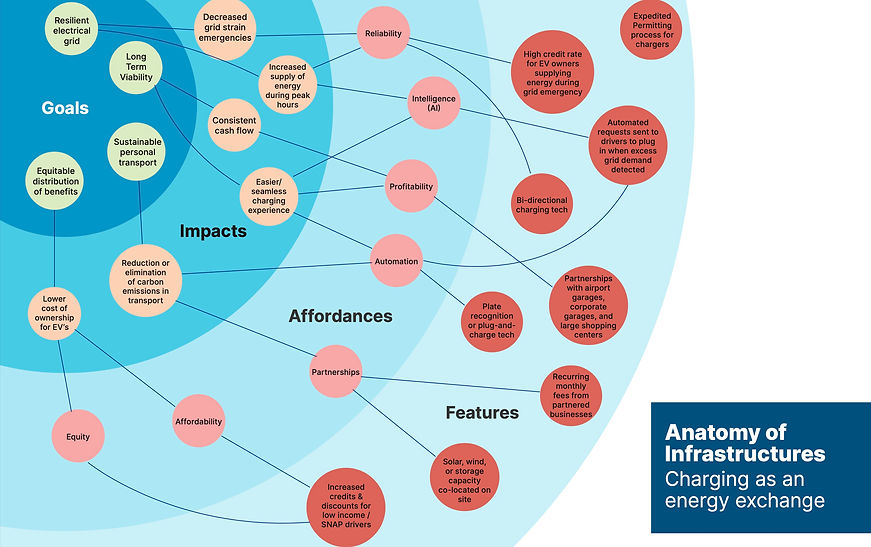Isaac Jang
Rethinking Systems
of EV Charging
Exploring sustainable investments in infrastructure through systems research, opportunity exploration, and prototyping at multiple scales

Partner: OMERS (Ontario Municipal Employees Retirement System)
Duration: 5 weeks
Tags: Sustainability, investment, EV charging, infrastructure, systems, networks
Tools Used: InDesign, Illustrator, Photoshop
Skills Used: Systems thinking, equity analysis, causal loop mapping, stakeholder identification and mapping, prototyping (lo-fi physical + Arduino), visual communication & layout

How can we design infrastructure that is both sustainable and investable?
Designing Investable Infrastructure
Capital investment in infrastructure and the design process are two powerful forces that shape the world around us. Investment decisions in infrastructure directly affect human behavior and outcomes, but haven't benefited significantly from the capabilities of the strategic design process.
The idea of "capital design" is that private, long-term investment by institutions can be conducted in concert with strategic systems design tools, enabling the exploration of infrastructures and systems at different levels, interactions, and opportunities. This allows us to examine infrastructure through the lenses of sustainability, equity, and distributed intelligence—a capability that is much less present in typical investment portfolio construction.
Process and goals
In this project, we aimed to rethink existing concepts of EV (electric vehicle) charging systems, making use of systems thinking tools and small-scale prototyping to create future concepts that are both sustainable and investable.
This process requires us to examine the current landscape of charging, anticipated trends in consumer behavior, emerging resesarch and technologies, historical inequities, and competing infrastructure projects.
Note: This project was planned and scoped as a systems-research-through-prototyping project. As such, typical design process activities like user research and insight generation fell outside the scope. Instead, trends & futures reports and research publications were used as the basis on which to conduct synthesis and prototyping.

Values and Framings
Systems Values
Our "research through prototyping" process was guided by three systems goals.
Decarbonization
Archetypes should support a landscape that is transitioning away from fossil fuels and towards carbon-free power and mobility.
Decentralization
Infrastructure has historically been built and controlled by a powerful few. Our archetypes should distribute design, access, and ownership across communities, leading to more informed and inclusive features.
Digitization
AI and IoT technologies will only become more ubiquitous over time—therefore, our archetypes should leverage these capabilities in a thoughtful manner to enable services and relationships that were not previously possible.


Reframing Current Archetypes
Examining current archetypes yielded opportunities for re-thinking common behavior patterns and incentives.
The current archetype of refueling an ICE (Internal Combustion Engine) car involves navigating to a dedicated fueling station, interacting with the pump, and waiting several minutes while energy in the form of gasoline is exchanged. Importantly, gasoline is only available at gas stations, and generally cannot be resold by the consumer.
EV charging offers an opportunity to question the assumptions around what "refueling" entails.
What if...
...charging did not require direct interaction from the consumer?
...the energy for charging could come from distributed or consumer-generated sources?
...consumers could exchange energy at different times to take advantage of variable pricing?

Archetype 1: Mobile EV Charging
Drop-in Charging Solutions
Mobile charging concepts are a significant future archetype of EV charging. Many existing parking infrastructures may not allow for traditional fixed chargers or would be costly to retrofit. Mobile charging services can offer a flexible deployment of charging in difficult situations as well as grid storage capability to utilities, in addition to offering a convenience benefit to consumers.

Autonomous & Mobile Charging
Institutions face high costs for equipment and installation when considering the implementation of EV charging. Additionally, local infrastructure may not be prepared for the projected rates of electricity transmission. De-coupling the charging equipment in the form of a battery-charging autonomous vehicle avoids these issues.
Intelligent Optimization
Intelligent and connected charging allows customers to communicate with their EVs and optimize the charging process based on factors such as battery capacity, energy demand, and charging rates.


Archetype 2: Energy Exchange
A System of Exchange
What if EV drivers could use their vehicles as a way to earn credit for supporting grid stability? The feature of bidirectional charging, currently being implemented by various manufacturers, allows fleets of EV’s connected to the grid to act as a unit of grid storage.
Owners could receive compensation for supplying back to the grid during high demand periods, or charge at home using renewable sources and sell back when connected to the grid at a work parking lot.
In this archetype, we prototyped a service concept that takes this technology to the next level: detailing energy exchange relationships, value exchanges, interactions, and equity impacts.
Induced Supply and Demand
Bi-directional charging and grid storage / demand response systems make for natural partners. This relationship is even more valuable when demand on the grid is anticipated and responded to, by enticing drivers to make their cars available as energy storage.
Long-term Institutional Contracts
Organizations with large parking garages, such as airports, malls, or corporate parks, already control access and impose fees. Partnering with these entities piggybacks on an archetype consumers are already familiar with (pay to park) and allows for mutual benefit and long-term cash flow.
Variable, Equitable Pricing and Credits
Imposing fees and awarding credit for energy used or supplied by drivers creates an opportunity not just for incentivizing behaviors, but also for accounting for inequities and marginalization. The pricing system could leverage tolling information, license plate databases, or even SNAP/EBT purchases to identify those who could benefit from reduced fees/increased credits.

This systems tool, the Action-Situation, illustrates and describes a moment of interaction within a system, highlighting the actors and networks involved.
UI prototypes of the proposed mobile experience for the service help to clarify the driver's relationship with the system at the interaction level.


Understanding the Landscape
Knowing the basics
Understanding the current state of EV charging in the U.S. was critical to effectively prototyping future archetypes. We relied on trends & industry reports from firms like PwC to ground ourselves in the economics and technologies of EV charging.


Electric vehicles and the charging infrastructure: a new mindset?
(Telang et al 2021)

Understanding systems change
Also critical was understanding how technological changes propagate through systems at different levels. Seminal works such as Technological transitions as evolutionary reconfiguration processes: a multi-level perspective and a case-study (Geels 2002) were consulted at the start of the process.
Diagram: The multi-level systems perspective (Geels 2002)

Research through prototyping
Exploring interactions through small-scale prototypes
Arduino enabled us to explore the features and interactions of systems archetypes at a small scale, using simple code and circuits to model complex technologies and interfaces. This level of rapid prototyping quickly unveiled both real-world capabilities and constraints.

Prototyping at scale
Archetype features were also explored at the human interaction level through full-scale prototypes. These representations of intersecting stakeholders and technologies reveal previously-hidden opportunities and patterns.
For example, it became clear that any autonomous charging solutions would have to account for potential bad actors seeking to unplug vehicles for fun or personal gain—representing an opportunity for solutions like locking plugs, robotic arms, or a virtual security presence.
Demonstrating a vehicle-to-grid charging feature with our full-scale prototypes

Thinking in Systems
We used different systems tools to make sense of who is in a system, what its boundaries are, how system goals connect to features, and how trends and flows relate to each other.

The Anatomy of Infrastructures tool helps connect the desired goals of new systems to the individual features being discussed, revealing their impacts.



Final visuals by Mitchell Kunichoff
In this unconventional causal loop diagram, changes and trends are examined through the lens of equity and barriers to change.

This business model canvas helped to articulate how long-term cash flow could be achieved within the proposed new sustainable systems.
Final Report
Our final presentation, prototypes, and report were shared with select Ph.D students, the project partner (OMERS), and guests in attendance from The Invert, a local infrastructure startup seeking to transform former industrial land in south Chicago.
Layout, visuals, and text by Isaac Jang
Attributions
EV Charging Student Team
Isaac Jang
Ayaka Uriu (Amélie)
Keval Parekh
Mitchell Kunichoff
Jie An (Andrew)
Works Cited
Geels, Frank W. “Technological Transitions as Evolutionary Reconfiguration Processes: A Multi-Level Perspective and a Case-Study.” Research Policy, vol. 31, no. 8, Dec. 2002, pp. 1257–74. ScienceDirect, https://doi.org/10.1016/S0048-7333(02)00062-8.






